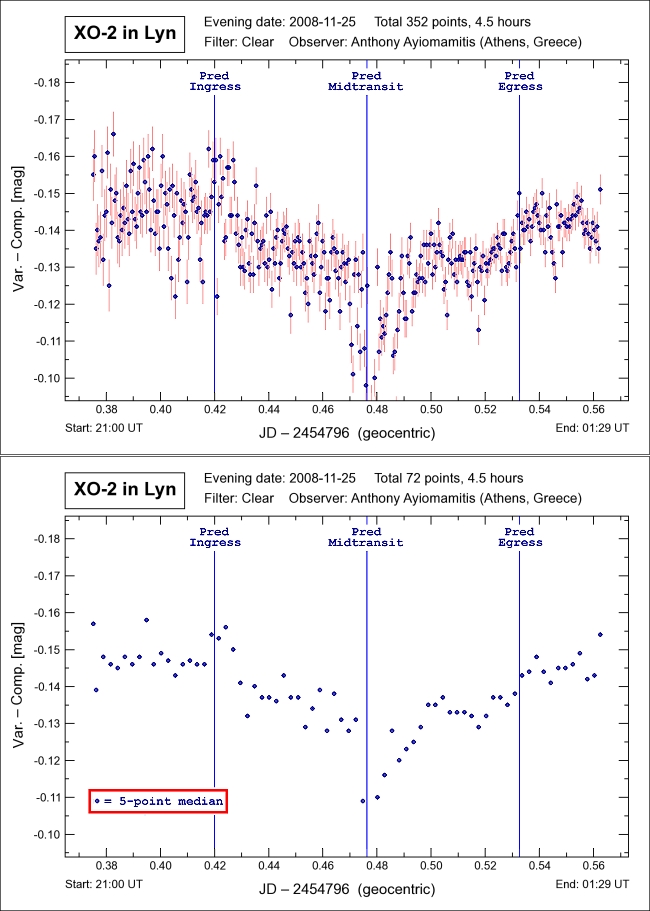
A variable star, as its name suggests, is a star whose magnitude varies intrinsically, in contrast to eclipsing binaries whose magnitude
varies as a result of one star in the binary system eclipsing the other. True variables are one of five types, namely Mira stars, semiregular
stars, cepheids, eruptive variables and, finally, cataclysmic variables. Minimum to maximum magnitude can range from days to many months with
some variables displaying irregular periods.
A popular method for the study of variable stars, particularly short-term variables, is by the use of the technique known as "differential
photometry". Rather than measure the (variable) magnitude of a variable star on an absolute scale, measurements are made over time relative to
one or more non-variable star(s) and these differences are then plotted so as to study and illustrate the relative or differential change in
magnitude. Due to the very large number of variables stars, the field of differential photometry represents one of the key fields in astronomy
whereby the amateur astronomer can make a meaningful and long-lasting contribution to both science and astronomy.
More recently, the search for extrasolar planets (over 275 discovered so far) has identified yet another interesting application for the
practice of differential photometry whereby the minute drops in magnitude of a star hosting an exoplanet are studied. Further details for the
interested party are available here.
Note: The light curve for XO-2b in Lynx depicted below is one of the latest transitting exoplanets, having being
announced mid-2007, and is particularly unique since it represents a clear collaboration between professional and amateur astronomers where
the research team led by Peter McCullough (Space Telescope Science Institute, USA) identifies a number of potential candidates using widefield
imaging and amateurs are asked to pursue the photometry thereafter of promising candidates.
XO-2b is characterized with a mass and radius 0.57 and 0.973 times that of Jupiter, respectively, and an orbital period of only 62.8 hours.
XO-2b requires 162 minutes to transit its parent star at a depth of 12.0 mmag (1.20%). The parent star, GSC 3413:0005, is an K0V dwarf star
estimated to have a mass of 0.98 solar masses, a radius equivalent to 0.97 solar radii and a temperature of 5,340° K. As is the case with
HAT-P-1, XO-2 has a close binary twin (GSC 3413:210) with a similar spectrum and magnitude which lies only 31" away. Further details regarding
XO-2 and XO-2b are available in the paper published by the discovery team led by Christopher Burke et al (click
here).
Note: The C- and K-stars used for the purposes of the differential photometry measurements depicted below were
GSC 3413:104 (11.2) and GSC 3413:11 (mag 11.2), respectively. Due to extremely volatile seeing during the session, approximately sixteeen
integrations involved a single saturated pixel for XO-2 near the predicted mid-transit point and which adversely affected the result below.
|
Parent Star: XO-2 GSC Catalog: GSC 3413:0005 Constellation: Lynx RA / Dec: 07h 48m 07s / +50° 13' 33" Magnitude: 11.18 Distance: 486 light-years Exoplanet: XO-2b Period: 2.615838 + 0.000006 d Transit Duration: 162 minutes Transit Depth: 12.0 mmag Minimum Mass: 0.57 MJup Radius: 0.973 RJup Pred Transit Details:
|
 |
Date: Nov 25-26, 2008 23:00 - 03:30 UT+2 Location: Athens, Greece Equipment: AP 160 f/7.5 Starfire EDF AP 1200GTO GEM SBIG ST-10XME SBIG CFW-8 AstroDon TruBal CRGB Integrations:
Temperatures:
Software: CCDSoft V5.00.188 AIP4Win V2.2 Processing: Reduction Differential Photometry |